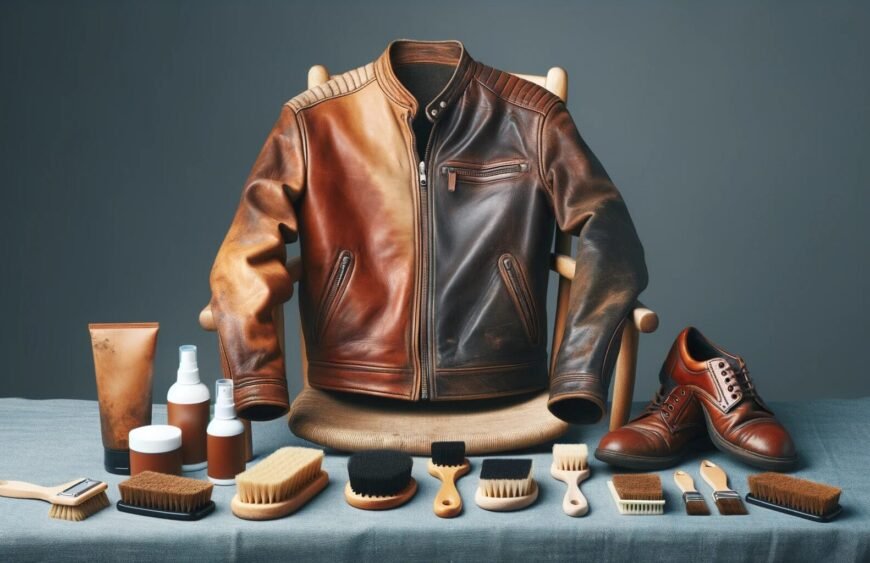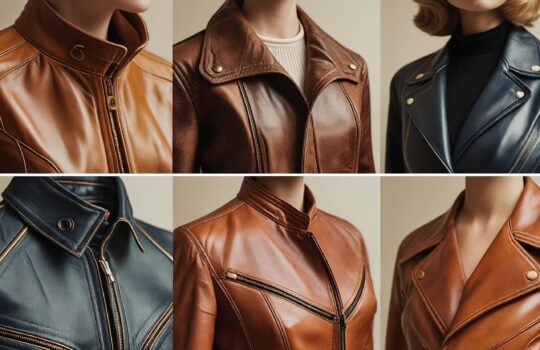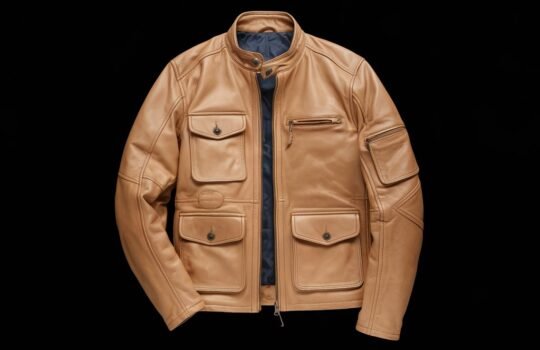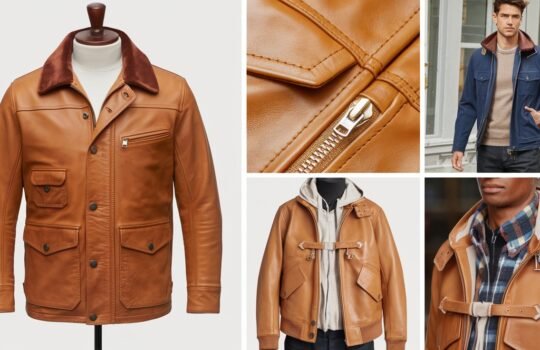How to Repair and Restore Your Leather Goods
Even the highest-quality leather products can show signs of wear over time. At Gear Hikes Team, we’re dedicated to helping you restore your favorite leather pieces. Here’s a guide to repairing and reviving your leather goods.
1. Minor Scratches and Scuffs
For minor scratches, use a leather conditioner to buff them out. Gear Hikes Team recommends using a color-matching conditioner for a seamless finish.
2. Replacing Zippers and Hardware
Sometimes, the hardware on your leather bag or jacket may wear out. Visit a professional leather repair service to replace zippers or metal clasps. Gear Hikes Team offers a warranty on many of our products, ensuring your item can be restored to its former glory.
Understanding Leather Wear and Tear
Leather is a favored material due to its durability and timeless appeal; however, it is not impervious to wear and tear. Over time, leather goods encounter various forms of deterioration that can detract from their aesthetic and functional value. Common signs of wear may include minor scratches, fading of color, and hardware deterioration, which can occur even with the best care. Recognizing these signs is crucial for maintaining the integrity of leather products.
Minor scratches
Minor scratches are perhaps the most frequent issue faced by leather items. These imperfections can happen as a result of daily use or accidental contact with rough surfaces. While some scratches can be minimal and hardly noticeable, others may require immediate attention to prevent further damage. Treating scratches promptly with a specialized leather conditioner or polish can often restore the appearance of the leather.
Color fading is another prevalent issue
Color fading is another prevalent issue that leather goods face, particularly if they are regularly exposed to sunlight or harsh environmental conditions. Prolonged exposure to UV rays can cause discoloration, leading to an uneven and unsightly appearance. To combat fading, it is advisable to store leather items in shaded areas and employ protective sprays designed to guard against such degradation.
Hardware deterioration, which includes the tarnishing of buckles, snaps, and zippers, can also impact the functionality of leather products. Regular cleaning and maintenance of metal components can significantly extend their lifespan. It is essential to inspect hardware frequently and apply appropriate cleaning solutions to prevent rust and tarnish buildup.
Understanding these common signs of wear and tear is vital for leather care. Regular maintenance, including conditioning and protective treatments, can help prolong the life of leather goods, ensuring they continue to perform well and remain visually appealing. Proper attention will set the stage for addressing these typical issues effectively, allowing one to enjoy their leather products for years to come.
Repairing Minor Scratches and Scuffs
Leather goods can often sustain minor scratches and scuffs, diminishing their overall appearance. However, with the right techniques, these blemishes can be effectively repaired. One of the most efficient methods involves using a leather conditioner, specifically one that matches the color of your leather items. This approach not only nourishes the leather but also helps in hiding imperfections, restoring its original charm.
To begin the repair process, it is important to assess the extent of the damage. For minor scratches, a high-quality leather conditioner can work wonders. First, clean the area around the scratch using a soft cloth to remove any dust and debris. This allows the conditioner to penetrate the leather more effectively. Next, apply a small amount of the color-matching leather conditioner onto a clean, lint-free cloth. Remember to choose a conditioner specifically designed for your type of leather, be it smooth, suede, or nubuck, as different materials require different care products.
Gently rub the conditioner into the scratched area in circular motions. This technique not only helps the conditioner adhere to the leather but also encourages the fibers to realign and minimize the appearance of the scratch. Ensure that the conditioning product is thoroughly blended into the surrounding leather to achieve a seamless look. After the initial application, allow the leather to dry for a few minutes before inspecting the scratch again.
If necessary, repeat the process for deeper scratches to achieve the desired result. Additionally, it is advisable to regularly condition your leather goods as a preventative measure against future scuffs and scratches. By following these steps and selecting the right products, you can maintain the beauty of your leather items, prolonging their lifespan while keeping them looking their best.
Replacing Zippers and Hardware: When Professional Help is Needed
Leather goods often require extensive care and maintenance to prolong their lifespan, especially when it comes to certain repairs that may exceed the skill level of the average consumer. One such area is the replacement of zippers and hardware, such as metal clasps, buckles, or rivets. These components are not only functional but also contribute significantly to the overall aesthetic of the item. Over time, wear and tear can lead to malfunctioning zippers or damaged hardware, prompting the need for repairs. Understanding when to seek professional help is essential for ensuring your leather goods maintain their quality and functionality.
How to Repair and Restore Your Leather Goods
While simpler fixes such as cleaning or conditioning can often be handled at home, the replacement of zippers and hardware typically requires specialized tools and expertise. If you find that your zipper is stuck, splitting, or completely broken, it may be time to consult a professional leather repair service. Attempting a DIY fix could lead to additional damage, ultimately resulting in more costly repairs down the line.
When selecting a reliable provider for leather repair, look for companies with a strong reputation and testimonials from previous clients. A skilled professional will not only replace zippers and hardware with precision but will also ensure that the integrity of the leather is maintained during the repair process. Additionally, inquire about the warranty services offered by the repair company. For instance, Gear Hikes Team prides itself on its commitment to restoring high-quality leather products and offers guarantees on their workmanship. This gives customers peace of mind, knowing that their beloved leather goods will receive the level of care and attention they deserve.
In conclusion, when faced with complex repairs such as replacing zippers and hardware on leather goods, recognizing the need for professional assistance is crucial. Investing in quality repairs ensures longevity and retains the value of your leather items.
Preventive Measures to Maintain Leather Goods
Maintaining leather goods is crucial for extending their lifespan and ensuring they retain their aesthetic appeal. Effective preventive measures involve regular cleaning, conditioning, and proper storage practices. By adopting a proactive approach, leather items can remain in pristine condition for years to come.
First and foremost, regular cleaning is essential. Dust and dirt can accumulate on leather surfaces, potentially leading to scratches and degradation over time. It is advisable to use a soft, damp cloth to wipe down leather goods periodically. For deeper cleaning, a specialized leather cleaner can be used, but it is important to follow the manufacturer’s recommendations to avoid damaging the material.
How to Repair and Restore Your Leather Goods Conditioning is another vital preventive measure. Leather can dry out and become brittle without adequate moisture. Using a high-quality leather conditioner every few months can help replenish oils and maintain suppleness. This step not only protects against cracks and creases but also enhances the leather’s sheen, keeping it looking fresh. It is prudent to test any conditioner on a small, inconspicuous area before applying it to the entire surface to ensure compatibility.
Proper storage practices also play a significant role in maintaining leather goods. Avoid exposing leather to direct sunlight or heat sources, as these can cause fading and warping. Instead, store leather items in a cool, dry place, ideally in breathable dust bags to prevent dust accumulation. Additionally, utilizing padded hangers or keeping leather goods in their original cases can help maintain their shape.
Finally, be mindful of common mistakes, such as using harsh chemicals or neglecting protective treatments. It is vital to refrain from overwashing leather or using products that contain alcohol, as these can compromise the leather’s integrity. By integrating these preventive measures into your routine, you can effectively preserve the quality of your leather goods for years to come.
Conclusion: How to Repair and Restore Your Leather Goods
In summary, the maintenance and repair of leather goods is essential in preserving their longevity and aesthetics. Although leather is renowned for its durability and resilience, it is not impervious to the effects of time, environmental factors, and daily use. Regular upkeep is therefore critical, starting with basic practices such as cleaning, conditioning, and protecting your items from moisture and extreme temperatures.
It is equally important to address any signs of wear or damage promptly. Minor issues such as scuffs or scratches can often be repaired with simple techniques, while more significant damage may require professional assistance. Implementing these practical maintenance tips can help ensure that your Gear Hikes Team leather products remain in excellent condition longer, allowing you to fully enjoy their functionality and style.
By creating a consistent maintenance schedule and being proactive about repairs, you can mitigate common issues faced by leather materials. Whether through applying conditioners, using appropriate cleaning agents, or investing in protective measures, every small effort contributes to the overall health and appearance of your leather goods. Remember, an ounce of prevention can save a pound of cure, especially when it comes to keeping your leather items looking their best.
Ultimately Goal
Ultimately, by embracing these routines and nurturing your leather goods, you secure an investment that continues to enrich your lifestyle over the years. Leather is not only a material choice but a journey, and with the right care, it can accompany you through many adventures, enhancing its character with time. Thus, equip yourself with knowledge and implement these strategies to uphold the quality and elegance of your leather products for many years ahead.
How to Repair and Restore Your Leather Goods: Leather goods are built to last, but they do require occasional upkeep. By following these repair tips, your Gear Hikes Team leather products will stay in top condition for years to come.
46 MOTORCYCLE LEATHER RACING JACKET
Adrenaline Rush Moto America 2025 Motorcycle Leather Racing Jacket
Adrenaline Rush MotoGP 2025 Motorcycle Leather Racing Jacket
AdventureMaster Dakar Rally 2025 Motorcycle Leather Jacket
Apex Racer MotoGP 2025 Motorcycle Leather Jacket
Apex Rider Superbike World Championship 2025 Leather Jacket
APRILIA BLACK MOTORCYCLE LEATHER RACING JACKET
APRILIA BLACK KNIGHT MOTORCYCLE LEATHER RACING JACKET
APRILIA BLACK MEN MOTORCYCLE LEATHER RACING JACKET
Read More: The Ultimate Guide to Caring for Your Leather Goods























